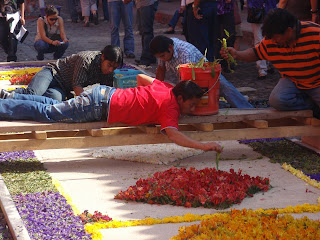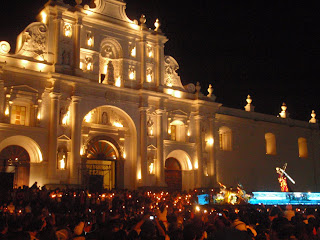I would be amiss to not include the splendor of Antigua in it’s peak of cultural celebration. All during Cuaresma (Quick language lesson…cuarenta=40, Cuaresma=Lent, a period of 40 days), churches put up velaciones—I’ve mentioned these Holy Vigils before, it’s a huge representation of a Bible story—and perform weekly processions carrying elaborate floats of Jesus and the Virgin Mary, followed by bands playing funeral marches through the streets.
During Semana Santa, Antigueῆos make alfombras (carpets) out of colored sawdust, pine needles, flowers, fruits and vegetables and other creative materials. They can be up to 50 feet long and 10 feet wide (by my estimations) and are created over the cobblestone streets using giant stencils over which they spoon the sawdust from scaffolds a foot above the ground. Most alfombras take anywhere from 6-12 hours to produce with typically a group of 5 or more people working at once. Intricacy varies from carpet to carpet as you wander the streets gawking at the creations, and no two are alike from year to year.
 Alfombra in progress, laying on scaffolding, carefully adding rosebuds to the diamond shape in the middle of the design.
Alfombra in progress, laying on scaffolding, carefully adding rosebuds to the diamond shape in the middle of the design.  Sawdust alfombra made in front of Pollo Chapincito, a little fried chicken restaurant on my street. Yes, that is a whole chicken and gravy cup sitting on a plate, as an offering.
Sawdust alfombra made in front of Pollo Chapincito, a little fried chicken restaurant on my street. Yes, that is a whole chicken and gravy cup sitting on a plate, as an offering. Something to note: Alfombras are created as offerings. There are no cash prizes for the most intricate or time consuming, there is no sign on the corner saying, "Jill created this alfombra, she deserves a cookie." Alfombras are an incredible act of anonymous devotion. As the carriers of the processions walk over the sawdust, the intricate designs are muddled, and immediately after the procession passes, a clean-up crew follows with brooms and shovels.
 Alfombra made of pine needles and vegetables, complete with a mini arch at the other end! Pat and I came across this one around 6:30am on Good Friday—the streets were packed, as most people leave their houses at 4am to see the procession leave the church that day. We were such lazy bums.
Alfombra made of pine needles and vegetables, complete with a mini arch at the other end! Pat and I came across this one around 6:30am on Good Friday—the streets were packed, as most people leave their houses at 4am to see the procession leave the church that day. We were such lazy bums. Processions are dramatic, beautiful, emotional events. Every church in the area creates floats to be carried by up to 90 people, each toting near 100 pounds on one shoulder, depicting Jesus carrying his cross, or Mary weeping in prayer. The brotherhoods associated with each church raise money for and create the float, and organize the encargados (carriers). On the day of the procession, a procession may leave the church at 11am and walk the city streets until 2am. The encargados trade places beneath the float every block, and I have heard estimates of 6,000 men being part of one procession.
 It’s tough to get the full view, but this Palm Sunday float is over 100 feet long, about 10 feet wide , and is being carried by 90 men.
It’s tough to get the full view, but this Palm Sunday float is over 100 feet long, about 10 feet wide , and is being carried by 90 men. The typical order of performance goes like this: a drum and flute player in cucurucho walk first, announcing the coming of the procession. Then comes another cucurucho swinging incense, and more men lining either side of the street, making way for the float. Often then we see representations of the saints or apostles, sometimes carried on poles in pieces of art, sometimes carried as statues by 4 cucuruchos. More incense, sometimes men wearing the uniform of a Roman soldier, sometimes men representing various characters like Pontius Pilate or judges. Important: none of these characters walk over the alfombras. As the float comes through, some of the cucuruchos carrying the float walk over the sawdust, but mostly the carpet passes under Jesus and the Virgin Mary and then is swept away. First, the Jesus float passes, followed by a 20 or 30 piece marching band, then more incense and women lining both sides of the street, dressed in traditional black veils. Women carry the Virgin float, up to 50 women in each block-long turn, as this float is not as long nor heavy as Jesus’. Following Mary, another band of the same size, playing yet a different funeral durge.
 Maundy Thursday procession entering the Cathedral in Central Park, after walking the streets for 12 hours. The blue light is the huge float, Pat and I were standing in a crowd of about 500, so pardon the lack of zoom on my little camera.
Maundy Thursday procession entering the Cathedral in Central Park, after walking the streets for 12 hours. The blue light is the huge float, Pat and I were standing in a crowd of about 500, so pardon the lack of zoom on my little camera. Then come the brooms, shovels and trash truck to clean everything up, and following that, vendors with cotton candy, cucurucho dolls and other random paraphernalia that tends to ruin the beautiful devotion that has just passed.
No comments:
Post a Comment